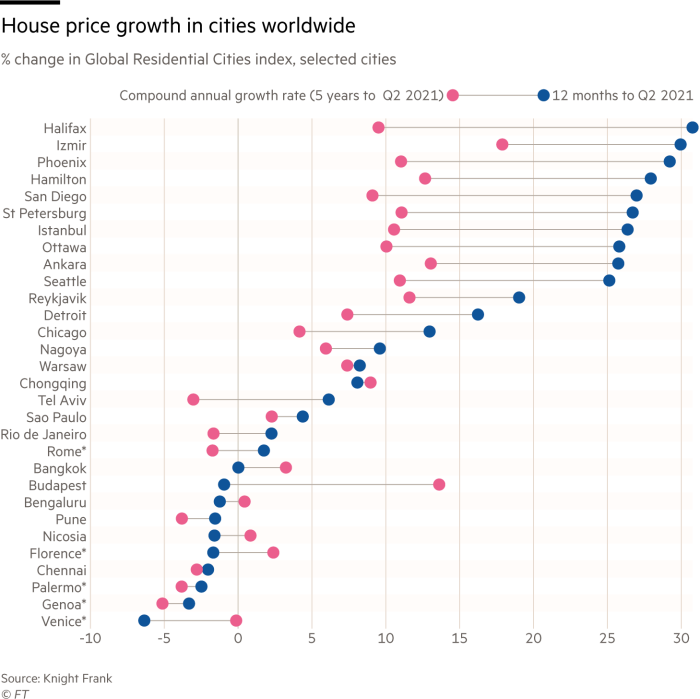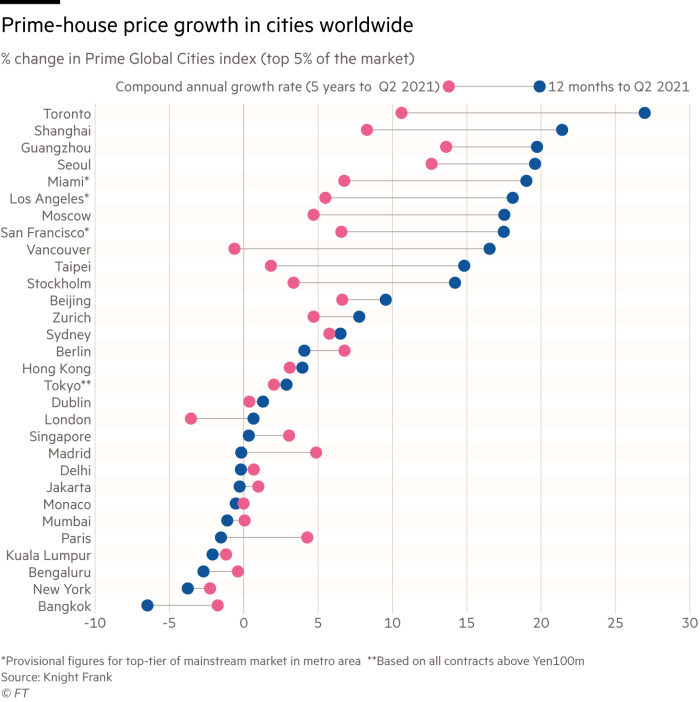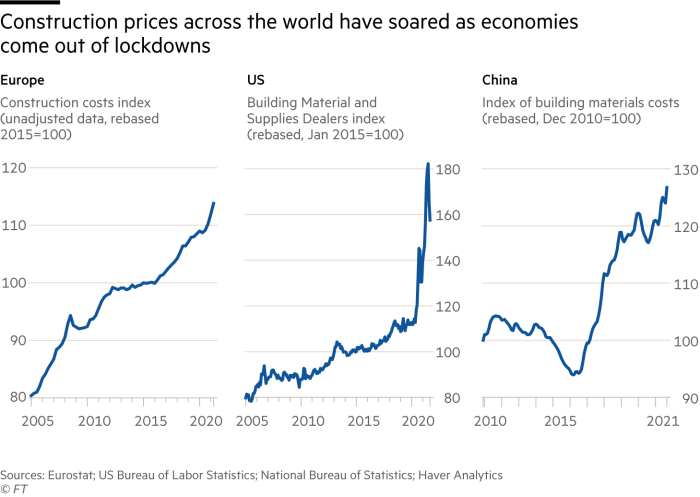Interest rate hikes will not dim the allure of property
Roula Khalaf, Editor of the FT, selects her favourite stories in this weekly newsletter.
The pandemic surge in property prices has reached around the globe. From Turkey to New Zealand, from Russia to Australia, house prices have soared in the past year.
Overall, prices rose 9.2 per cent across 55 countries in the 12 months to the end of June, according to research from Knight Frank, a property agent. The developed world led the way with a 12 per cent gain, well ahead of the 4.7 per cent increase in developing countries.
The price surge is a result of the gush of cheap money that central banks released into the markets as their co-ordinated contribution to helping the global economy avoid disaster during the Covid-19 outbreak. The funds helped to reassure investors that asset prices would be stabilised in the face of the pandemic’s economic shocks.
However, as the charts show, the advances largely bypassed London and New York, and other leading global cities, such as Tokyo, Hong Kong and Paris, where prices marked time, albeit at historically high levels. Instead, the increases were posted in centres where investors saw catch-up opportunities: San Francisco, Los Angeles and Toronto, for example, and Shanghai, Seoul and Moscow.

In some cases, expatriates have been buying property in their home countries, often out of concern that, in a post-pandemic world, it might be harder to move around the globe. Alongside them are domestic and international investors, including many wealthy families, who have been encouraged by ultra-low interest rates to add to their property portfolios.
How much more can prices surge? There are signs that the extended price appreciation in property and financial assets could now be accompanied by more general price inflation, triggered by the post-pandemic economic recovery and the re-emergence of shortages of everything from microchips to lorry drivers.

Central bankers initially insisted that the price surges were transitory. Now, though, they seem to be less sure about that. The spike in energy prices has uncomfortable echoes of the 1970s, when an oil supply shock helped trigger years of persistent inflation. Meanwhile, labour shortages are fuelling wage hikes, which tend to spiral as companies compete with each other for staff.
All this generates pressure on central banks to raise rates from the ultra-low levels of much of the past decade. Other things being equal — which admittedly they rarely are — that will weaken the property price surge. As Knight Frank says: “Despite strong price growth, there are signs of softening demand in some markets.”
What happens next depends on what kind of interest rate hikes come. Financial traders are betting on step-by-step increases, which are least likely to upset confidence. And that is what central banks are likely to aim for. Having spent years assiduously bolstering economic growth with near-zero rates, they are not likely to change gear suddenly, if they can avoid it.
But the risk exists that central banks might be forced to take unexpectedly drastic action, especially if they are shown to have delayed too long in their response.
Still, it seems clear that, whatever the gyrations of the markets, most of us seem to have an innate fondness for real assets, starting with owning a place we can call home.

For the rich, the attraction of property is particularly compelling. The wealthy put about a third of their assets into property, a figure that rises to nearly half in Asia, wealth managers say. They like to have homes in the leading cities, seaside resorts and ski villages. They buy apartments close to prestigious private hospitals and top-class schools and universities.
Shifts in interest rates may influence the timing of such purchases and the prices paid, but the basic allure remains undimmed.
Stefan Wagstyl is the editor of FT Wealth and FT Money. Follow Stefan on Twitter @stefanwagstyl
This article is part of FT Wealth, a section providing in-depth coverage of philanthropy, entrepreneurs, family offices, as well as alternative and impact investment
Comments